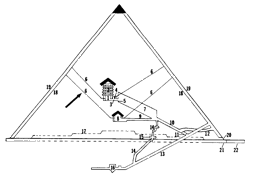 |
Science Frontiers ONLINE No. 89: Sep-Oct 1993 |
|
|
A ROBOT'S MYSTERIOUS DISCOVERY
 A cross-section of the Great Pyramid looking west. The King's Chamber is #1 on the diagram, the Queen's Chamber is #8, the ventilation shafts are #6. The arrow marks the location of the newly discovered "door" and possible chamber. (Adapted from: W. R.; Pyramid Odyssey, 1978 |
"At the end of the polished section was what appears to be a door, made of the same tura limestone and with tongue-and-groove fittings on the side that suggest it can be raised and lowered. It has two corroded copper fittings in the center; a piece of one fitting had broken off and was found lying in front of the stone. A small gap exists at the bottom of the stone, but the camera could not peer through it."
But what could lie beyond this tiny door deep in a shaft too small for humans? Is there a hidden chamber? Might it contain the body of Khufu, builder of the Great Pyramid, whose remains have never been found? A suspicious layer of black dust outside the door suggests the past presence of organic matter.
Egyptologists find the whole business "very annoying." German archeologist R. Stadelman stated, "There is surely no other chamber."
Meanwhile, Gantenbrink plans to slip a fiber-optic camera through the crack under the "door" to resolve the matter.
(Maugh, Thomas H., II; "A Robot's Mysterious Discovery," San Francisco Chronicle, May 2, 1993. Cr. J. Covey. Also found in the Wellington, New Zealand, Evening Post. May 1, 1993. Cr. P. Hassall.)